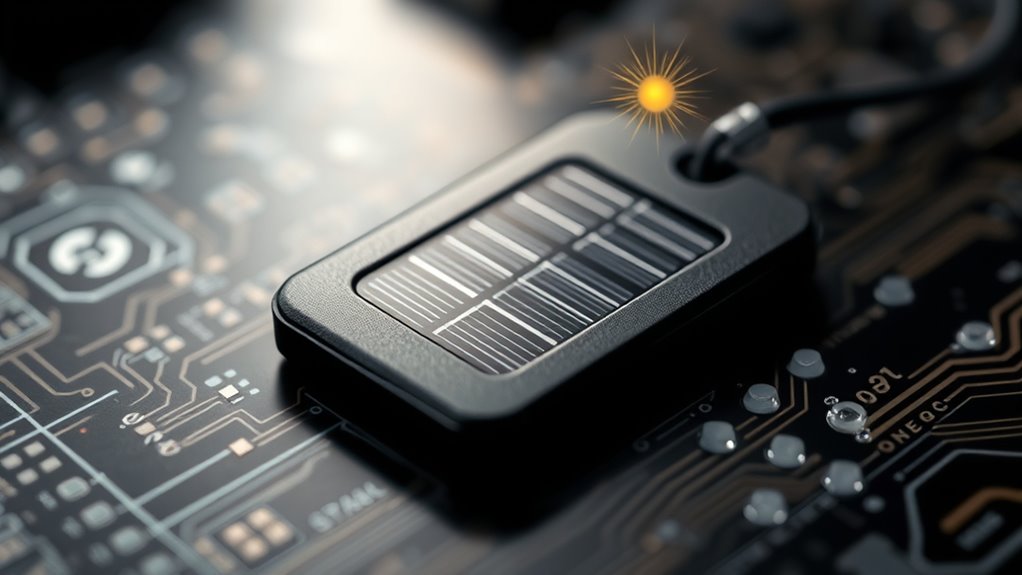Battery-free Bluetooth tags work by capturing ambient energy from sources like light, vibrations, heat, or radio signals using small transducers such as solar cells or piezoelectric materials. This energy is converted into electrical power through specialized circuits and stored in capacitors, powering the tag’s microcontroller and Bluetooth module. Because they rely on surrounding energy, these tags can operate indefinitely without batteries, making them sustainable. To explore how this innovative system actually functions, keep going to find out more.
Key Takeaways
- Energy harvesting converts ambient sources like light, vibration, or RF signals into electrical power for Bluetooth tags.
- Components such as transducers, rectifiers, and power management circuits enable efficient energy capture and storage.
- Harvested energy powers the Bluetooth radio and microcontroller, allowing operation without batteries.
- Environmental energy variability can affect the device’s performance and data transmission capabilities.
- Ongoing innovations improve efficiency, miniaturization, and durability, expanding the potential applications of battery-free Bluetooth tags.
The Principles Behind Energy Harvesting

Energy harvesting is the process of capturing and converting ambient environmental energy into usable electrical power. You leverage natural sources like light, vibrations, or heat, and transform them into electricity without batteries. This process involves specialized materials and devices called transducers, which detect energy fluctuations and generate electrical signals. For example, photovoltaic cells convert sunlight into electricity, while piezoelectric materials generate power from vibrations or movement. You don’t need large, complex equipment—small, efficient harvesters can supply enough energy for low-power devices like Bluetooth tags. The key principle is capturing energy from your surroundings continuously, so devices can operate sustainably without needing frequent battery replacements. This technology is particularly useful in remote or hard-to-reach environments where replacing batteries is impractical. This approach makes devices more reliable, eco-friendly, and ideal for long-term use in various environments.
Types of Ambient Energy Sources

Ambient energy sources are abundant in our environment, providing multiple options for powering battery-free devices like Bluetooth tags. You can tap into various forms of energy that are naturally present around you. These include:
- Solar energy – harnessed through small photovoltaic cells that convert sunlight into electricity.
- Vibration energy – generated by mechanical movements, like footsteps or machinery, using piezoelectric materials.
- Thermal energy – derived from temperature differences, such as heat from the human body or ambient air.
- Radiofrequency energy – captured from existing wireless signals like Wi-Fi, TV broadcasts, or cell towers.
Each source offers distinct advantages, making energy harvesting versatile and adaptable for different environments.
Components of a Battery-Free Bluetooth Tag

A battery-free Bluetooth tag relies on a carefully integrated set of components that work together to harvest, store, and transmit data without the need for a traditional power source. Key elements include an energy harvester, which captures ambient energy like RF signals, light, or vibrations. A power management circuit then regulates this energy, ensuring it’s usable. An energy storage component, such as a capacitor, temporarily holds the harvested energy for consistent operation. The microcontroller manages data processing and controls the radio frequency (RF) transceiver, which handles wireless communication with Bluetooth devices. Ultimately, an antenna captures and transmits signals. Each component plays a crucial role, enabling the tag to operate autonomously, efficiently, and sustainably without batteries. Additionally, understanding energy harvesting techniques is essential to optimizing the functionality of these tags.
How Energy Is Converted and Stored

You rely on ambient energy sources like light, vibration, or radio waves to power these tags. Conversion techniques transform this energy into usable electrical power, often using specialized circuits. Once generated, energy is stored in tiny capacitors or supercapacitors to keep the device running reliably. Additionally, advancements in projector technology have enabled more efficient energy harvesting methods for low-power devices.
Harvesting Ambient Energy
How do battery-free Bluetooth tags power themselves without traditional batteries? They harvest ambient energy from their surroundings. This energy comes in various forms and is captured by specialized components. Here’s how it works:
- Radiofrequency (RF) energy from nearby signals like Wi-Fi, RFID, or cellular towers.
- Light energy collected from indoor lighting or sunlight via tiny solar cells.
- Vibrational energy generated by movement or mechanical vibrations, converted by piezoelectric materials.
- Thermal energy from temperature differences, captured through thermoelectric generators.
Once collected, this energy is stored temporarily and used to power the tag’s circuitry. This process allows the tags to operate without batteries, relying solely on ambient energy sources.
Conversion Techniques Used
To convert ambient energy into usable power, battery-free Bluetooth tags employ specialized electronic components that transform raw energy into electrical current. These components include rectifiers, voltage regulators, and power management circuits. Rectifiers convert AC signals from sources like RF, light, or motion into DC power. Voltage regulators ensure a stable voltage output, preventing damage to sensitive electronics. Power management circuits optimize energy flow, capturing bursts of energy and smoothing fluctuations. Some tags use AC-to-DC converters for radio frequency energy, while photovoltaic cells harvest light directly into electrical current. Piezoelectric elements generate power from vibrations or mechanical movement. Energy conversion methods work together to efficiently convert diverse ambient energies into electrical energy, enabling the tags to operate without batteries while maintaining reliable performance.
Storage Mechanisms Employed
Since ambient energy sources can be intermittent and unpredictable, battery-free Bluetooth tags incorporate specialized storage mechanisms to guarantee consistent operation. These mechanisms ensure energy is available when needed. First, supercapacitors store excess energy from harvesting, providing quick charge and discharge cycles. Second, thin-film batteries offer longer-term storage, often recharging during periods of abundant energy. Third, energy buffers such as electrolytic capacitors smooth out fluctuations, maintaining stable power. Lastly, some tags use hybrid systems combining supercapacitors and batteries to optimize both rapid response and sustained power. These storage components enable the tags to operate reliably despite inconsistent energy input, ensuring continuous Bluetooth communication and data transmission without traditional batteries. Additionally, wireless connectivity components require stable power supplies, which these storage mechanisms efficiently provide.
Powering Bluetooth Communication Without Batteries

Powering Bluetooth communication without batteries relies on innovative energy-harvesting techniques that capture ambient power sources. These tags use tiny energy harvesters—such as solar cells, piezoelectric devices, or thermoelectric generators—to gather energy from environmental stimuli like light, vibrations, or temperature differences. Once captured, this energy is stored briefly in supercapacitors or small capacitors to provide a steady power supply. When a device needs to transmit data, the stored energy powers the Bluetooth radio, enabling wireless communication. Because these systems draw very low power, they can operate continuously without batteries, relying solely on their ambient energy sources. This approach not only reduces maintenance but also enhances device longevity and sustainability, making battery-free Bluetooth tags practical for many applications.

Energy harvesting tags offer the key benefit of power independence, reducing the need for batteries and maintenance. However, they rely on limited energy sources like light or motion, which can restrict functionality. As a result, their application may face constraints in environments with inconsistent energy availability. Additionally, the diverse designs available can influence the efficiency and suitability of these tags for specific applications.
Power Independence Advantages
Energy harvesting tags offer notable benefits by allowing devices to operate independently without relying on batteries or external power sources. This power independence means you don’t need to replace or recharge batteries, reducing maintenance costs and downtime. Instead, these tags harness ambient energy, making them more sustainable and eco-friendly. Here are some key advantages:
- Continuous operation without battery replacement
- Lower total cost of ownership over time
- Reduced environmental impact due to less waste
- Enhanced deployment flexibility in hard-to-reach or remote areas
Additionally, understanding the overview of energy harvesting techniques can help optimize the performance and integration of these tags in various applications.
Limited Energy Sources
While energy harvesting tags offer significant advantages, their reliance on limited energy sources can pose challenges. These tags depend on environmental energy like light, motion, or RF signals, which aren’t always consistently available. This variability can affect their performance and reliability. For example, a tag powered by light won’t work in dark environments, and one relying on vibrations may fail in quiet settings. The table below highlights common energy sources, their typical applications, and limitations:
| Energy Source | Typical Use | Limitation |
|---|---|---|
| Light | Indoor/outdoor lighting | Inconsistent or absent in darkness |
| Motion | Moving objects | Limited when still or stationary |
| RF Signals | Wireless signals | Weak or unavailable in some areas |
Additionally, the market growth projected for AI tech by 2025 reflects the increasing integration of smart, energy-efficient solutions in various devices.
Application Constraints
Although energy harvesting Bluetooth tags offer the advantage of eliminating batteries, their application comes with notable constraints. First, their performance depends heavily on environmental conditions, which can be unpredictable. Second, the energy harvested may not always suffice for continuous operation, limiting data transmission frequency. Third, their range can be restricted due to lower power output compared to traditional tags. Fourth, integration challenges exist, as the hardware must be optimized for low energy consumption and specific energy sources. Additionally, variability in energy sources can significantly impact the reliability of these tags. These constraints mean you need to carefully assess your environment and application requirements. While they excel in low-power scenarios, energy harvesting tags may not meet the demands of high-frequency data updates or long-distance communication. Understanding these limits helps you choose the right solution for your needs.
Future Developments in Battery-Free Tag Technology

What advancements can we expect in battery-free Bluetooth tag technology in the coming years? You’ll likely see increased energy harvesting efficiency, allowing tags to operate reliably in a wider range of environments. Improvements in miniaturization will make tags smaller and more discreet, expanding their use cases. You can also anticipate smarter power management circuits that maximize energy use and extend operational life. As materials and manufacturing processes evolve, expect tags to become more durable and cost-effective. Integration with new sensing technologies will enable more sophisticated data collection without external power. Additionally, advancements in communication protocols could boost data transfer rates and range. Overall, these developments will make battery-free tags more versatile, reliable, and easier to deploy across diverse industries. Moreover, innovations in energy harvesting techniques will further enhance the sustainability and performance of these tags.
Frequently Asked Questions
How Long Do Battery-Free Bluetooth Tags Typically Last in Real-World Conditions?
You’re wondering how long battery-free Bluetooth tags last in real-world use. These tags typically last several months to a few years, depending on factors like the energy harvesting method, environment, and activity level. Since they don’t rely on batteries, they continuously gather energy from ambient sources like light or motion. With proper design and favorable conditions, you can expect them to work reliably for extended periods without needing replacements.
Can Energy Harvesting Tags Operate Effectively in Low-Light or Low-Energy Environments?
You wonder if energy harvesting tags work well in low-light or low-energy settings. These tags can operate effectively because they capture ambient energy from sources like light, motion, or radio waves. While performance may decrease in very dim environments, advances in energy harvesting technology help guarantee they remain functional with limited energy. So, even in low-light or low-energy conditions, these tags can still perform, though with some potential limitations.
What Are the Cost Differences Between Battery-Powered and Energy-Harvesting Bluetooth Tags?
Imagine you’re tracking equipment in a remote warehouse. Battery-powered tags might cost more upfront and require regular replacements, adding ongoing expenses. In contrast, energy-harvesting Bluetooth tags often have higher initial costs but save money over time because they don’t need batteries replaced. Overall, energy-harvesting tags can be more cost-effective long-term, especially in hard-to-reach or low-maintenance environments, reducing operational costs and downtime.
How Do Environmental Factors Affect the Reliability of Energy Harvesting in Tags?
Environmental factors critically influence the reliability of energy harvesting in tags. You’ll find that temperature fluctuations can boost or hinder energy collection, while humidity and moisture may cause corrosion or short circuits. Light availability impacts solar harvesters, and vibrations or movement are essential for piezoelectric or kinetic sources. To take into account these factors and possibly incorporate protective measures or supplementary power sources.
Are There Any Privacy Concerns Associated With Tracking Using Battery-Free Bluetooth Tags?
You might worry about privacy when tracking with battery-free Bluetooth tags, but these systems are designed with security in mind. They typically transmit data only when in close range, reducing tracking risks. Plus, since they don’t store personal data on the tags themselves, unauthorized tracking becomes much harder. So, while privacy concerns are valid, proper implementation and security measures help keep your information safe and private.
Conclusion
By embracing energy harvesting, you open a future where batteries no longer hold you back. You reduce waste, increase reliability, and simplify maintenance. You harness ambient energy, power your devices effortlessly, and create smarter, more sustainable solutions. You move toward a world where technology and nature work in harmony, where innovation meets responsibility, and where battery-free Bluetooth tags become a seamless part of everyday life. Embrace the change, and let energy harvesting transform your connectivity.

